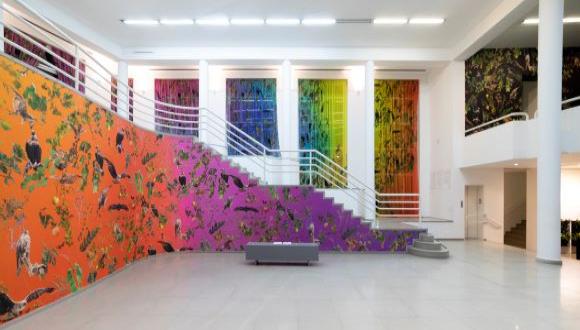What's in the Gallery?
t/%D7%9B%D7%95%D7%AA%D7%A8%D7%AA%20%D7%A4%D7%9C%D7%90%D7%A0%D7%98%20%D7%9C%D7%93%D7%91%D7%A8%20%D7%94%D7%90%D7%95%D7%A6%D7%A8%D7%99%D7%9D.jpg)
The COVID-19 crisis has stimulated a renewed discourse on the relationship between humans and their natural surroundings, as well as the impact of our choices on the state of Planet Earth. The ancient attempt to triumph over nature has been challenged during the past year by a microscopic virus, elusive and constantly changing, that completely altered our lives. The exhibition "Plan(e)t" was born before the onset of this crisis, yet it developed over the course of the pandemic, taking on new meanings. At the heart of the exhibition are plants, portrayed as complex creatures that make a valuable contribution to our survival on Earth.
We tend to view plants as objects: in the room there is a table, a chair, and a potted plant; outside there is a building, a bench, and a tree. Even though we know that plants are developing beings, we mostly associate them more with the world of objects than with the world of living things – their growth rate is too slow for the human eye to observe, and our contact with them is primarily instrumental. Yet in the reality of a health and climate crisis, the dichotomy between nature and culture no longer suits humanity’s relationship with the world.
Via a series of projects which integrate scientific research with artistic endeavor, “Plan(e)t” presents an original perspective on the encounter between the animal and plant kingdoms, which share the same territory. This initiative stems from the recognition that sustainable thinking must include a reevaluation of the hierarchy that places plants on a lower rung than living beings, and humans in particular. The subtitle of the exhibit, “Plants Think, Think Plants,” declares its underlying logic: plants are “thinking” beings, and therefore we must think of them in more complex ways than we have done up to now.
The artworks comprising “Plan(e)t” conceive of the plant as a cultural embodiment of the complex relations between power and sustainability. They achieve this by relating both to the local context and to a broad historical view. A majority of the works were created specifically for the gallery space, and most of them have continued to grow and change during the months of the exhibition. Over the past year – between and during lockdowns – an outdoor project was also erected in the gallery's sculpture garden. This unique project combines processes of construction and destruction in which Earth and nature reclaim their control. The artistic experience of the works before us generates a new approach – more thoughtful, affirming, and sustainable – towards the world we live in.
Dr. Tamar Mayer and Dr. Sefy Hendler
Curators: Dr. Tamar Mayer and Dr. Sefy Hendler
Assistant Curator: Darya Aloufy // Yifat Pearl
Participants: David Burns and Austin Young (Fallen Fruit) // Relli de Vries // Stéphane Thidet // Dr. Dafna Langgut // Dr. Yasmine Meroz // Liat Segal // Onya Collective // Noam Rabinovich


